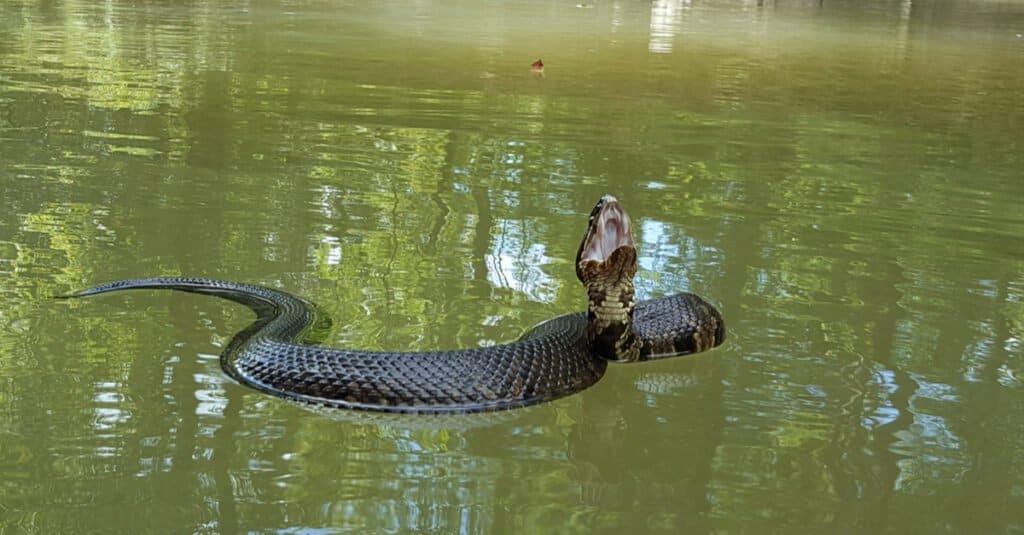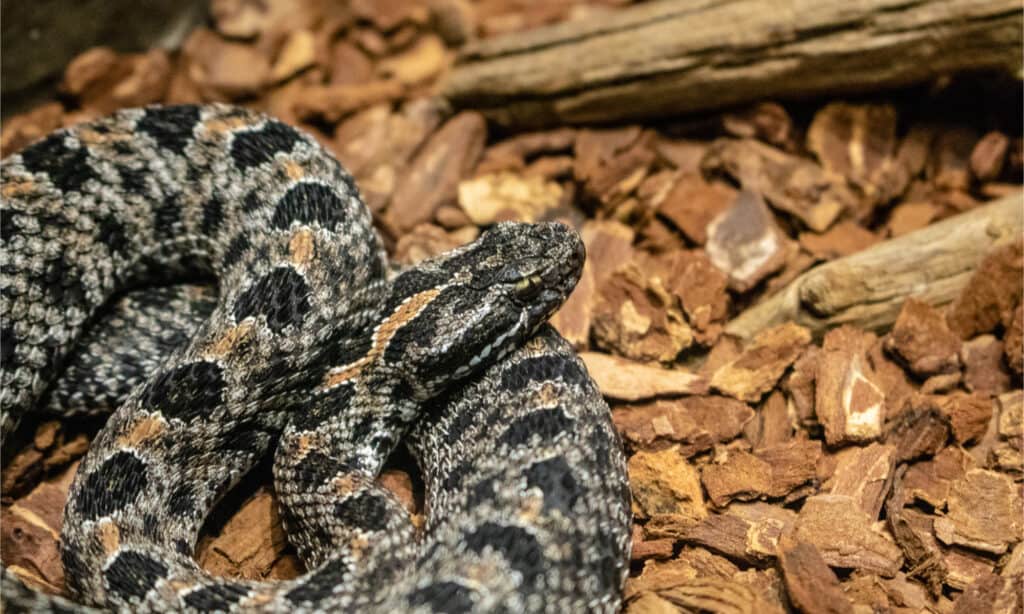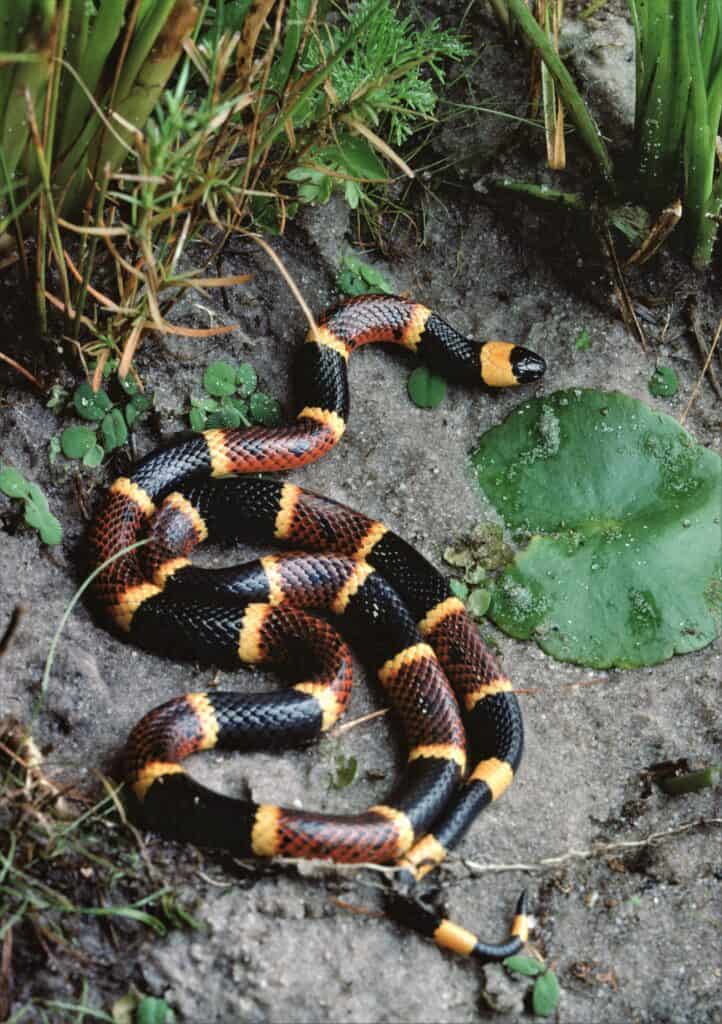There are around 40 species of snakes in Alabama, but not all of them are dangerous. Of all the snake species in the state, there are 6 venomous (poisonous) snakes in Alabama. Some might look like non-venomous snakes, so you might want to keep your distance if unsure.
Snakes play an important role in controlling rodent and insect populations, and venomous snakes use venom to capture and kill prey. Let’s look at the 6 different venomous (poisonous) snakes in Alabama.
1) Copperhead

Copperheads are the most common venomous snake in Alabama.
©Creeping Things/Shutterstock.com
The copperhead is the most common venomous snake in Alabama. It can be found throughout the state, with the subspecies northern copperhead in the north and southern copperhead in the south. Northern copperheads have a darker base color that is more reddish brown, whereas the southern copperheads have a tan base color. Both have dark brown hourglass-shaped markings and a copper-colored head. Most snakes are around 2 feet long but can get up to 4 feet. Babies snakes are born with a bright yellow tail that they use to wiggle to attract prey.
Copperheads are venomous, but they have the least toxic venom of all the venomous snakes in the U.S. They are not aggressive and tend to steer clear of humans.
2) Cottonmouth

Cottonmouths get their name from the white inside of their mouth.
©Seth LaGrange/Shutterstock.com
Cottonmouth venom is much more potent. The venom is hemotoxic and destroys blood cells; sometimes causing hemorrhaging. Hence it is important to seek immediate medical attention if a cottonmouth has bitten you. Cottonmouths are also called water moccasins and are found in wetlands and waterways. They can be found throughout Alabama but have larger populations along the coast. These large-bodied snakes will swim along the top of the water and, when they are upset, will flash their mouth wide open. This is why they are called cottonmouths. Average adults are around 4 feet long, but some can get to be 6 feet or more. The adults are typically all black with faint markings.
3) Timber Rattlesnake

Alabama has three kinds of rattlesnakes, including the large Timber rattlesnake.
©Frode Jacobsen/Shutterstock.com
The Timber rattlesnake is one of three rattlesnakes in Alabama. If you come across one, you may see them coiled up with their rattle sticking out, shaking back and forth to give a warning. The head of the snake may be raised off the ground, alert, mouth open, hissing at a threat. Timber rattlesnakes have several colorations, but a common one is a tan base color with dark brown markings and a dark reddish brown stripe all along the length of the back. They are thick-bodied and average 3 ½ -5 feet in length, although they can get bigger.
In Alabama, you can find timber rattlers in all 67 counties, and they prefer hardwood forests and cane thickets. In southern Alabama, they may be referred to as canebrakes. During the winter, you may find a den filled with timber rattlesnakes because they brumate (hibernate) together.
4) Pigmy Rattlesnake

Even though the pigmy rattlesnake is not very big, it can still be very venomous.
©Suzanna Ruby/Shutterstock.com
The smaller pigmy rattlesnake may be small, but it is still venomous. They are rare in Alabama, so sightings are sparse, but they have been found in the state’s southernmost counties. Pigmy rattlesnakes, sometimes called “ground rattlers,” prefer life on the ground, and if you came across one all curled up, they would be about the size of a large pine cone. They are 1 ½ -2 feet long and have a small rattle at the tip of their tail. There are three subspecies of pigmy rattlesnakes that live in Alabama:
- Carolina pigmy rattlesnake: light gray base color with dark brown spots and reddish markings. Found in the northern third of Alabama.
- Dusky pigmy rattlesnake: dark gray base color with dark brown/black spots and a reddish brown stripe down the dorsal side. Only found in the Lower Coastal plains.
- Western pigmy rattlesnake: grayish-brown base color with dark crossbars. Only found in the western section of central Alabama.
5) Eastern Diamondback Rattlesnake

Alabama’s largest of the 6 venomous (poisonous) snakes is the Eastern Diamondback rattlesnake.
©Chase D’animulls/Shutterstock.com
The Eastern Diamondback rattlesnake is the largest venomous snake in Alabama and the U.S. They can be 8 feet long and weigh 10 pounds, but the average size is 4-5 feet. They are thick-bodied and have a base tan color with yellow diamond-shaped markings along their back.
Not only are Eastern Diamondback rattlesnakes the largest venomous snake they are also one of the most deadly. They deliver large amounts of venom, which is more toxic than many other venomous snakes. Due to the combination of the large volume and toxicity, the bites can be fatal. Medical facilities in the U.S. have access to antivenin, which should be administered as soon as possible.
In Alabama, the Eastern Diamondback is rare and considered a species of high conservation concern. They live in the extreme southern coastal plains of Alabama, not throughout the state.
6) Eastern Coral Snake

The coloration of the eastern coral snake should warn you to stay away!
©iStock.com/Weber
The eastern coral snake has several snakes that mimic its looks to ward off predators. Eastern corals are black snakes with alternating red and yellow bands. They are skinny compared to the others on our list, and their heads are not much wider than their body. The other snakes that look a lot like them are the scarlet kingsnake, scarlet snake, and red milksnake. Coral snakes are around 2-3 feet long and spend much of their time burrowing in loose soil.
Eastern coral snakes are also very rare in Alabama and are considered a species of high conservation concern in the state. They are mostly in the lower coastal plains, but sightings have been rare. If you see one, keep your distance and never try to handle one. While some snakes, like a garter snake, don’t seem to mind being picked up, coral snakes will almost always bite, and their bites can be fatal. The safest thing is to keep your distance from all snakes that have the coloration of the coral snake.
The photo featured at the top of this post is © Joe McDonald/Shutterstock.com
Discover the "Monster" Snake 5X Bigger than an Anaconda
Every day A-Z Animals sends out some of the most incredible facts in the world from our free newsletter. Want to discover the 10 most beautiful snakes in the world, a "snake island" where you're never more than 3 feet from danger, or a "monster" snake 5X larger than an anaconda? Then sign up right now and you'll start receiving our daily newsletter absolutely free.
Thank you for reading! Have some feedback for us? Contact the AZ Animals editorial team.






